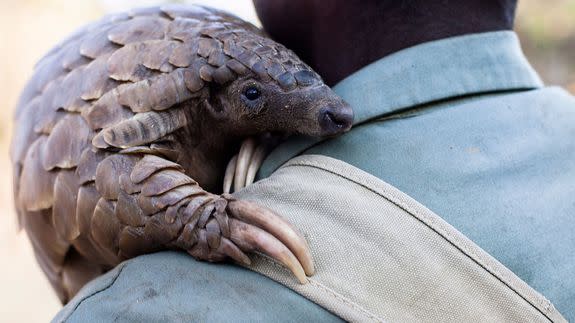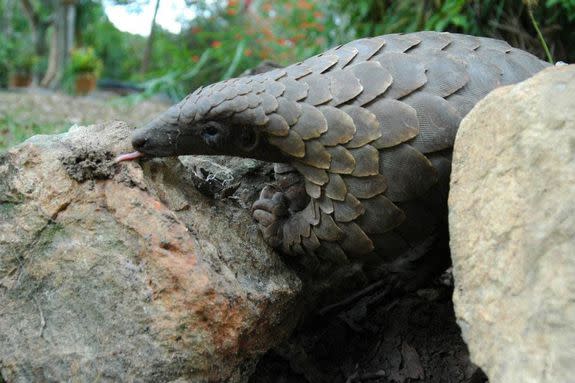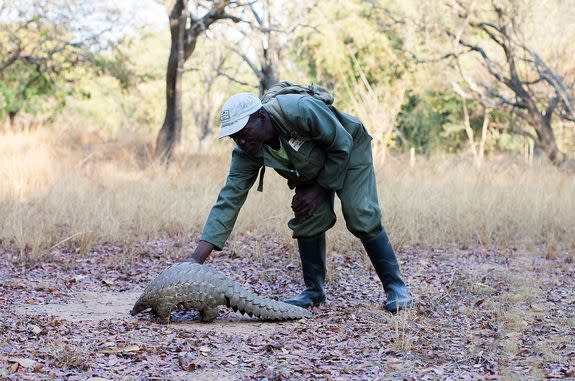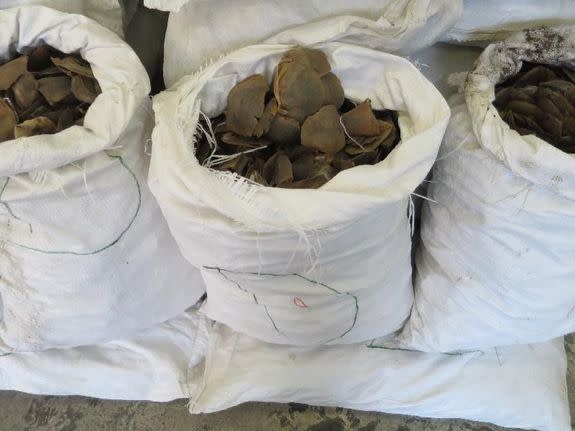Pangolins, the world's most trafficked mammals, get major boost in battle against extinction

The pangolin — a scaly, bug-eating, cat-sized anteater — may soon gain a higher level of protection as conservationists race to save the mammal from extinction.
Pangolins, native to Asia and Sub-Saharan Africa, are believed to be the most trafficked animals in the world. Their scales are a common ingredient in traditional Asian medicines, and their meat is considered a luxury food in many cultures.
SEE ALSO: Countries call for end to domestic ivory trade as elephants disappear
At a world wildlife conference in South Africa this week, countries are expected to give eight pangolin species the top level of protection under the Convention on International Trade in Endangered Species of Wild Fauna and Flora (CITES).

Image: Tikki Hywood Trust/u.S. fish and wildlife service
By listing pangolins in Appendix I — a group including species threatened with extinction — nations would agree to ban international commercial trade of pangolins and their parts in all but "exceptional circumstances," according to CITES.
"This decision will help give pangolins a fighting chance," Susan Lieberman of the Wildlife Conservation Society said in a statement from Johannesburg.
"These species need extra protection, and under CITES Appendix I, they will get it," she added.
Pangolins feed on ants and termites, using their claws to break into nests and their long, sticky tongues to lap up insects.
When a predator approaches, they roll up into a ball, with their scaly exterior protecting pangolins from the fangs of larger creatures. Sadly, this ball-rolling approach only makes it easier for poachers to snatch them.
A CITES subcommittee voted late last week to move pangolins into Appendix I from Appendix II, a less stringent designation that allows for some controlled levels of trade, so long as it doesn't threaten the species' survival.
The final CITES category, Appendix III, includes species that are protected in at least one country that has asked other nations to help control the trade.
Pangolins' change in status will become official if confirmed during the summit's plenary session this week. It would then enter into force 90 days later.
Wildlife experts estimate that more than 1 million pangolins have been traded illegally in the past decade — despite earlier efforts to halt the poaching and illegal trade of these nocturnal mammals.

Image: JEKESAI NJIKIZANA/AFP/Getty Images
CITES established a "zero annual export quota" for Asian pangolin species in 2000, and many countries in Africa and Asia with pangolin populations have already adopted domestic laws to prohibit the capture and trade of pangolins.
In the United States, one species of pangolin, the Temminck's ground pangolin, is listed as "endangered" under the U.S. Endangered Species Act.
But as Asian pangolin species become harder to find, due to dwindling populations and the zero export quota, traders are turning to African pangolin species to meet market demand, according to U.S. Fish and Wildlife Service.

Image: Hong Kong customs
This summer, Hong Kong officials said they discovered more than 8,800 pounds (4,000 kilograms) of African pangolin scales hidden in cargo labeled "sliced plastics" from Cameroon, the government said in a press release.
The haul, worth $1.25 million (HK$9.8 million), was estimated to represent between 1,100 and 6,600 pangolins.
Pangolins don't generally thrive in captivity, and they have a slow reproductive rate and low natural population density in the wild. As poachers snatch rising numbers of pangolins and urban development destroys their habitats, the mammals are increasingly nearing extinction, conservation groups have warned.

